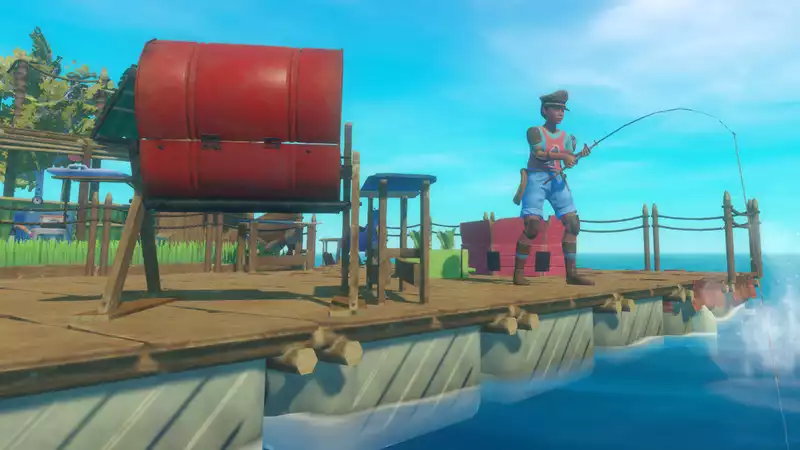Our oceans are clogged with plastic trash: it's that trash that keeps me alive In the open-world survival game Raft, which spent four years in Early Access before reaching 1.0 in June, I turned my collection of floating trash into a floating base. A big, messy, ugly floating base, but packed with life-saving amenities that I slowly came to love like home.
Like my raft itself, Raft the Game took quite a while to fall in love with. The first few hours were so rough that if I hadn't been writing reviews, I probably would have just quit. Constantly dying of malnutrition and dehydration, I was eager to throw my fragile plastic hook into the waves and fish out every piece of trash I could find. I fought off hungry sharks with a crude spear made of planks, rushed to passing small islands to gather handfuls of fruit to eat, and drifted slowly and miserably through the ocean on a tiny raft that I could not stop, steer, or control. Most of the crafting I did was to replace basic tools like garbage hooks and spears when they broke after a few uses. The early days were frantic, stressful, and not at all fun.
But after surviving for a few hours (and swearing frequently), I used the trash I'd collected to make the raft a little bigger and unlock new blueprints so I could make more useful items like seawater purifiers, fishing rods, and cooking grills... the one thing I wanted to stop doing on Raft, What made it very difficult to stop playing was the realization that what got me through the rocky early hours and led me to a more enjoyable ocean was not just the endless rivers of trash on the ocean that let me build things. It led somewhere.
Raft is not just a matter of craft and survival, but a mysterious riddle to be solved along with a gradually revealing story. Drifting from island to island, cutting down surplus trees for lumber, and digging up ore from the ocean floor, I was eventually able to build radio receivers, batteries, antennas, and other technology. Then one signal led me to a rusty, mysterious radio tower jutting out of the ocean, where clues I gathered pipped my radar screen. The clues I collected there showed a pip on my radar screen, and I was able to explore and loot another location and get the coordinates to the next location in the story. What began as a journey of aimless drifting now had several destinations, giving every craft a purpose beyond just catching enough fish to avoid starvation.
After building a tattered sail and a plastic shovel to use as a paddle, I finally ...... No, I can't steer the boat, but at least I can now aim for passing islands. Building an anchor allowed me to stop for a breather on the small islands I encountered, because gathering resources felt like a leisurely pleasure rather than a frantic task. Also, while in other survival games you may have to build multiple bases to reach the far reaches of the map, in "Raft" your bases follow you, so you don't have to start over from scratch.
There were some really exciting moments in following the story. After spending days visiting all these tiny, tiny islands, it was exciting to see something really huge looming on the horizon. We came across huge abandoned yachts, huge outposts made of cargo containers, mountain national parks towering above the waves.
These places were full of puzzles, little quests, new creatures to tame and fight, and useful loot. Audio diaries described what happened there (usually horrific), told us where everyone went, and gave us interesting details about the wet apocalypse. It was also nice to hear some voices in a world that, frankly, can sometimes feel very lonely (unless you play co-op with a friend). Most importantly, these story areas provided a welcome change of pace for Raft.
The real turning point came when we were able to bolt the wood-burning engine and handle to the raft. At long last, I was able to maneuver this big nasty base in any direction I wanted, instead of being helpless to float anywhere the wind blew me. I was no longer a mostly helpless passenger, but a brave explorer. Even better, we were able to net the edges of the raft, which automatically collected the floating debris. Thanks to a proper fishing rod, a bow and arrow to kill any foolish birds that landed on the raft, and an upgraded desalinization system, food and hydration were almost a non-issue.
That didn't mean it was smooth sailing from then on. There were still plenty of threats, such as ever-present sharks, islands with giant rats and terrifying bears, and the occasional craziness of trying to find resources to replace broken high-level gear, but the ability to automate some survival chores meant that I had more time to explore the world and enjoy it increased.
I hated the raft for the first few hours, but I grew to love it, and major new items like engines and handles gave the game a completely different feel, making the crafting progress feel powerful. My raft was still a mess, like trying to build a house around it with lots of furniture to start with. Still, I grew to love my mobile base and had plenty of free time to make modifications to make it work a little better. Gone are the days of running away from the raft to get food: it's dangerous to leave a raft behind without enough supplies.
In fact, there was so much extra trash that sometimes we even threw unwanted items over the side. I try not to think of it as pollution. Rather, it is like giving back to the ocean that has generously given me so much.
.

Comments